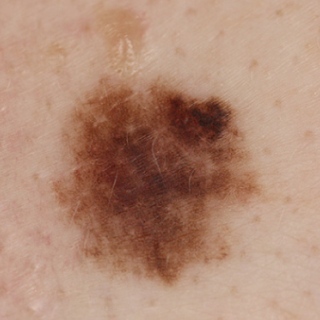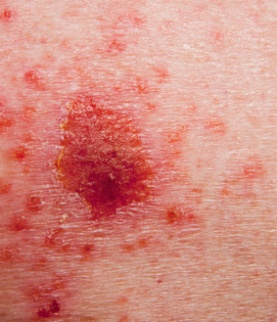There are 3 types of skin cancer that commonly occur, though there are others that are less common. We’ll tell you about the most common types and about the common treatments of skin cancer. If you have any unusual growths or discolorations of your skin, please see your doctor as soon as possible. While it might be something harmless like a mole or wart, it’s better to be safe and have a doctor look at it.
Most Common 3 Types of Skin Cancer

Melanoma is the type of skin cancer we hear the most about. It can develop anywhere on the body. On men, it’s most often found on the face or trunk of the body. On women, it’s most often found on the legs. Melanoma can, and often does, occur on parts of the body that haven’t been exposed to the sun very much, although excessive exposure to the sun does increase your risk of melanoma. In people with dark skin, melanoma often appears on the hands and feet, sometimes under the fingernails or toenails.
Melanoma may develop on normal-looking skin or a mole may become cancerous. A cancerous mole may change shape or color or grow larger. It may also itch, hurt, or bleed. Melanoma may also appear as a discolored spot on the skin, often irregular in shape. It might look like a sore that is not healing normally.

Basal cell carcinoma most commonly occurs on parts of the body that gets lots of exposure to the sun, like the face and neck. Sometimes it looks a lot like a scar, flat and flesh-colored or brownish in color. Other times it resembles a wart, a waxy-looking or pearly-looking bump.
Squamous cell carcinoma usually appears on areas of the body that are frequently exposed to the sun, although it can appear on other areas as well. It might look like a firm red bump or like a flat crusty or scaly lesion, similar to a scabbed-over sore.
Keep in mind the fact that there are more than 3 types of skin cancer. These are just the most common types.
Treatments of Skin Cancer
Regardless of which of the 3 types of skin cancer you have, there are a number of treatment options available. According to the Mayo Clinic, the best treatment for you will depend on a number of factors, including the size, depth, and location of the skin cancer. Sometimes a combination of treatments is recommended. With all types of skin cancer, early diagnosis and treatment is key to survival, so see your doctor about anything unusual going on with your skin.
Treatment options for skin cancer include:
- Cryosurgery, in which liquid nitrogen is used to freeze off cancerous lesions. It’s most often used for small lesions in the earliest stages of skin cancer.
- Excision, in which the cancerous tissue is surgically excised or cutaway. Sometimes a little surrounding tissue is also removed to make sure all of cancer has been removed. This procedure can be used to treat most types of skin cancer.
- Mohs surgery, in which the surgeon removes the cancerous lesion one layer at a time. Each layer is then examined under a microscope until no more abnormal cells are seen. Mohs surgery is typically reserved for harder-to-treat types of skin cancer, including basal cell carcinoma and squamous cell carcinoma. It is sometimes performed when cancer occurs in an area where doctors hope to save as much skin and tissue as they can, like on the nose.
- Radiation therapy, used sometimes when cancer cannot be fully removed with surgery. Surgery may still be performed in order to remove as much cancer as possible before starting radiation therapy.
- Chemotherapy, in which strong drugs are used to fight cancer. For small skin cancers, it is often administered topically with medical lotion or cream applied to the affected area. If cancer has spread, chemotherapy will be administered intravenously. It may be used in combination with surgery if not all cancer could be excised. When possible, topical chemotherapy is preferred because it typically causes far fewer side effects and side effects that do occur are usually less severe.
- Photodynamic therapy, in which drugs are administered to make cancer cells more sensitive to light and then a strong laser light is used to destroy the cancer cells.
If you’ve been diagnosed with skin cancer, you are probably very worried. Most types of skin cancer are very treatable, though. Talk to your doctor about your treatment options as well as your prognosis.

